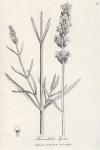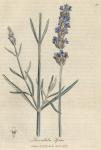
 Synonyma. Lavendula. Pharm. Lond. & Edinb.
Synonyma. Lavendula. Pharm. Lond. & Edinb.
Lavendula angustifolia flore caeruleo. Bauh. Pin. p. 216.
Lavendula minor sive spica. Gerard. Emac. p. 584. Raii. Hist. p. 513. Park. Theat. p. 73.
Pseudo-nardus quae Lavendula vulgo. J. Bauh. Hist. vol. iii. p. 282.
Lavandula foliis lineribus, spicis nudis. Hal. Stirp. Helv. n. 232.
Varietates sunt.
α Lavandula angustifolia flore caeruleo. Bauh. Pin. p. 216.
Narrow-leaved blue flowered common Lavender.
β Lavandula angustifolia flore albo. Bauh. l. c.
Narrow-leaved white flowered common Lavender.
γ Lavandula latifolia. Bauh. l. c.
Broad-leaved common Lavender. Vide Aiton. Hort. Kew.
Class Didynamia. Ord. Gymnospermia. Lin. Gen. Plant. 711.
Ess. Gen. Ch. Calyx ovatus, subdentatus, bractea suffultus. Corolla resupinata. Stamina intra tubum.
Spec. Char. L. foliis sessilibus lanceolato-linearibus margine revolutis, spica interrupta nuda.
The root is perennial, thick, fibrous, and woody: the stalk is shrubby, much branched, and often rises to the height of five or six feet; the bark of the younger shoots is of a pale-green colour, but of the old woody part of the stem rough and brown: the leaves are numerous, long, narrow, entire, without footstalks, of a whitish green colour: the flowers are produced in terminal spikes upon the young shoots, and are of a bright blue colour: the corolla consists of a long cylindrical tube, divided at the mouth into two lips, the uppermost of which is largest, and cut into two segments; the lower expands downwards, and separates into three: the filaments are four, two long, and two short, inclosed within the tubular part of the corolla, and support small simple antherae: in the place of a germen we find four naked seeds, from the center of which proceeds the style, which is slender, and furnished with a bilobated stigma. It is a native of the south of Europe, and flowers from July till September. This plant was formerly considered as a species of Nardus, and appears to be the Pseudo-nardus of Matthiolus and Pliny.
Lavender grows spontaneously in many of the southern parts of Europe; it appears from Turner to have been cultivated in England previous to the year 1568, [Vide Aiton's Hort. Kew.] and on account of the fragrance of its flowers, it is now so commonly cultivated, that we can scarcely enter a garden in which this plant is not to be found. The fragrant smell of the flowers is well known, and to most people agreeable; to the taste they are bitterish, warm, and somewhat pungent; the leaves are weaker and less grateful. "Water extracts by infusion nearly all the virtue both of the leaves and flowers. In distillation with water the leaves yield a very small portion of essential oil; the flowers a much larger, amounting in their perfectly mature state [In order to obtain the largest quantity of essential oil from these and most other flowers of this kind, they should be allowed to grow to their full maturity, and be dried for some time.] to about one ounce from sixty. The oil is of a bright yellow colour, of a very pungent taste, and possesses, if carefully distilled, the fragrance of the Lavender in perfection. [Hence it is frequently employed as a perfume. This oil has been used for stimulating paralytic limbs, and for other external purposes. We are also told that it effectually destroys cutaneous infects, and that if soft spongy paper be dipped in this oil, and applied to the parts, it immediately kills the pediculi inguinales.—This oil, distilled from the broad-leaved lavender, and mixed with three-fourths of rectified spirit, or oil of turpentine, was the Oleum spicae, formerly highly celebrated as an application to indolent tumours, old sprains, diseased joints, &c.] Rectified spirit extracts the virtue of Lavender more completely than water. The spirit elevates also in distillation a considerable part of the odoriferous matter of the leaves, and greatest part of that of the flowers; leaving in the inspissated extracts a moderate pungency and bitterness, with very little smell." [Lewis's Mat. Med. p. 371.]
Lavender has been an officinal plant for a considerable time, though we have no certain accounts of it given by the ancients: its medicinal virtue resides in the essential oil, which is supposed to be a gentle corroberant and stimulant of the aromatic kind, [Bergius says, Virtus: nervina, resolvens, tonica, emmenagoga. Usus: externus. M. M. p. 513.] and is recommended in nervous debilities and various affections proceeding from a want of energy in the animal functions. According to Dr. Cullen, it is, "whether externally applied or given internally, a powerful stimulant to the nervous system; and among the others of this order, named Cephalics, the Lavender has a very good and perhaps the best title to it." And he further says, "it appears to me probable, that it will seldom go further than exciting the energy of the brain to a fuller impulse of the nervous power into the nerves of the animal functions, and seldom into those of the vital. It may however be with great propriety, that Professor Murray has dissuaded its use where there is any danger from a stimulus applied to the sanguiferous system. It is however still probable, that Lavender commonly stimulates the nervous system only, and therefore may be more safe in palsy than the warmer aromatics, especially if the Lavender be not given in a spirituous menstruum, or along with heating aromatics, which however is commonly done in the case of the spiritus lavendulae compositus." [Mat. Med. vol. ii. p. 148.] The officinal preparations of Lavender, are the essential oil, a simple spirit, and a compound tincture.

